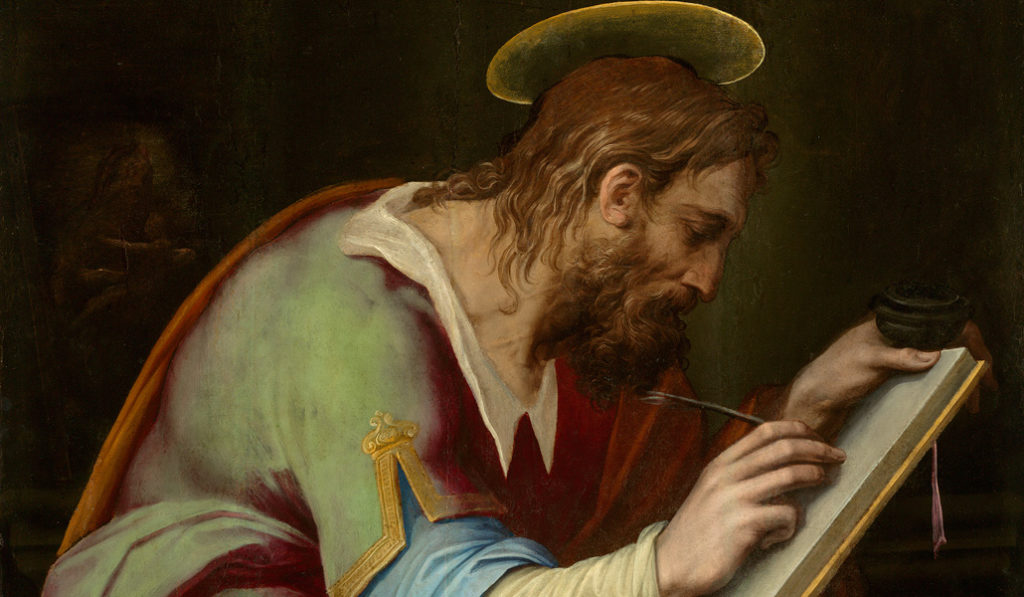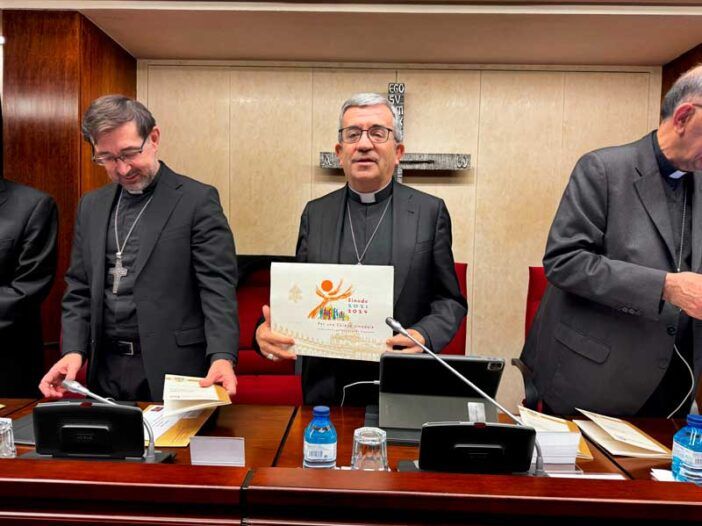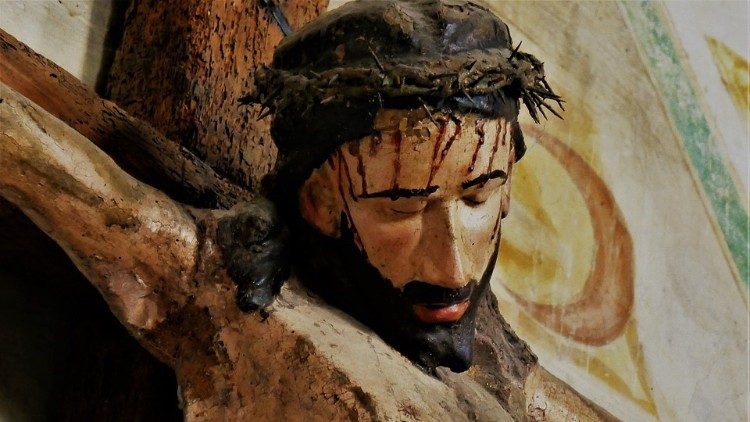Saint Luke, patron of doctors and artists
Biography of the Virgin and of the childhood of Jesus

The priest D. Manuel González López de Lemus offers an article on Saint Luke the Evangelist, patron of doctors and artists, whose feast is celebrated every October 18.
***
The name of Luke seems to come from the Latin term “lucius”, which means “luminous” or “shining”. However, some theories place its origin in Hebrew, meaning “hurricane”, or from the Greek Leukos, which means “brilliant, resplendent”. The name became popular in the Christian world due to being one of the four evangelists, Saint Luke. Whatever his origin, it is clear that the light and force of the hurricane are perfect for him.
We know from Tradition that Saint Luke was born in Antioch of Syria. This gives us information about his origin as a Gentile and not a Judaist. We do not know when he converted, although it is possible that it was very early. In any case, what is clear is that he was not a direct witness of the life of Our Lord Jesus Christ. He makes this clear when in the prologue of his Gospel he excludes himself from the eyewitnesses of the Master’s preaching: “After much effort was made to compile an account of the things fully confirmed among us, as they were handed down to us by those who were from the beginning eyewitnesses and ministers of the word, it seemed good to me, who have been following everything closely for a long time, to write everything down in an orderly fashion, the best Theophilus, so that you may know the certainty of the words in which you were taught” (Luke 1:1-4).
We know that Saint Luke is the author of the third gospel and of the Acts of the Apostles, this is a firm fact of Christian Tradition confirmed by the studies carried out on the texts themselves. He writes to Theophilus, who may be a real person or as the name indicates: Theos is God; Philia is love, that is to say: The Gospel is for those who love God.
In the Acts of the Apostles, St. Luke appears as a disciple and companion of St. Paul. In his account, he narrates some passages in the first-person plural: we, including himself, among those who took part in those journeys of the Apostle of the Gentiles. In other passages, he uses the expression they, making it clear that he was not an eyewitness to those events. However, we know that he accompanied St. Paul to Jerusalem, on the visit to Santiago and to the presbyters. Later he also goes to Rome with the Apostle, when the latter appeals to Caesar and in the letter to Philemon, St. Paul counts him among his collaborators.
The fact that he was a doctor by profession makes us suppose that St. Luke dedicated a lot of time to study and, therefore, was a very cultured person. All this is evident in the style of his books: his Gospel, which is the longest and the best written due to the refined and balanced use of Greek, as only a scholar like him could write: rich in terms that the other three evangelists do not have.
Another consideration must be made about his Gospel, in addition to his careful style and serious investigation of the facts: Luke is the evangelist who best draws the human figure of the Redeemer, his meekness and mercy towards repentant sinners; his attention to women, the poor and the needy.
He is the biographer of the Virgin and of the childhood of Jesus and according to tradition he met Mary, the mother of Jesus Christ, on a visit he made with Paul. By revealing to us the intimate secrets of the Annunciation, the Visitation, the Birth of Jesus Christ…, he makes us understand that he knew Mary personally. This is why Luke cites so many events from Jesus’ childhood. He also expresses Mary’s feelings, as if he were an eyewitness. Furthermore, some of these scenes have Mary as the only possible witness.
With literary skill, he seems to reveal his source of inspiration when he cites the following expression twice: “Mary kept all these things carefully, pondering them in her heart,” says Luke when the shepherds arrive at the manger to adore the newborn Jesus (Luke 2:19). And as the final touch to the Gospel of infancy, when recounting the scene of Jesus lost and found in the Temple, after expressing the surprise of the Virgin at the response of her Son, he again repeats the expression from which he lets us glimpse his source: “But they did not understand what he said to them. And he went down with them and came to Nazareth, and was subject to them. And his mother kept all these things in her heart” (Luke 2:50-51).
St. Luke is the only one who tells us the parables of the prodigal son and the Good Samaritan. He is the one who tells us the story of the disciples of Emmaus… It is clear that as a good doctor he is not only concerned with the health of the body, but that faith gave him a deeper vision of also curing the soul from sin, which is its worst illness. What is more, it supposes the death of the soul to the life of grace.
When I advise someone to read the gospels for the first time, systematically, I always recommend starting with the Gospel of St. Luke: firstly, because it covers more ground than any other: it goes from the annunciation of St. John the Baptist to Zechariah and ends with the Ascension of the Lord. Secondly, because it is written for pagans and that means for non-Jews. We are not Jews and St. Luke explains in detail many Jewish ceremonies, celebrations and traditions that are very useful and thirdly, being a cultured person, he makes the reading enjoyable, interesting and very pleasant. It is a magnificent appetizer to whet the appetite for reading the Gospels and thus open the knowledge of the person of Our Lord Jesus Christ.
Finally, he is also the patron of artists. Since, he is considered the author of the very famous image Salus Populi Romani, which is venerated in the Basilica of Santa Maria Maggiore. As with most Marian icons from the Greco-Byzantine area, according to tradition the Salus Populi Romani was painted by St. Luke on a piece of wood from the table used at Jesus’ Last Supper with his apostles or on a table built by the Redeemer himself that the Virgin Mary kept after his crucifixion. This same tradition says that it is a copy of an image that appeared miraculously in Lydda, in a church built by the apostles St. Peter and St. John.
As the patron saint of artists, he is a very important figure for the New Evangelization, which the popes have spoken about so frequently since 2000. Benedict XVI, for example, explained to us that for centuries the Church tried to seek the Truth by knowing the person of Jesus Christ in depth and gave primacy to intelligence. Later, the Church made a great effort to seek the Good, and thus sought the only way to resemble its model: Jesus. This made Christians develop asceticism, that is, the exercise of behaving well, under the dominion of the will.
Today, modern man does not understand well with his intelligence, due to his ignorance of the most elementary truths. He does not understand asceticism well, being surrounded by so much comfort and search for happiness through pleasures. However, beauty is something that impacts the human heart at all levels and in all cultures. We must strive to make art speak of that beauty because it is a participation of God, which is Beauty with a capital B.
It seems to me that the feast could not be more appropriate to ask Saint Luke to intercede for us as the doctor of our bodies and souls. In addition to asking him to intercede so that artists express with their works the beauty that naturally leads us to God.
D. Manuel González López de Lemus, priest.
YouTube: Fr. Manuel González / Facebook: Emmanuel J. González
Instagram: @mitogonzalez2013 / Blog: Spiritual Considerations
Related

“The priest finds his reason for being in the Eucharist”
Fundación CARF
01 April, 2025
5 min

Family Valued: An international appeal for the family
Exaudi Staff
01 April, 2025
2 min

Bishop Luis Argüello Addresses the Challenges of the Church in Spain
Exaudi Staff
01 April, 2025
2 min

THE WAY OF THE CROSS: Accompanying Jesus on the way to the Cross
Luis Herrera Campo
31 March, 2025
5 min
 (EN)
(EN)
 (ES)
(ES)
 (IT)
(IT)

